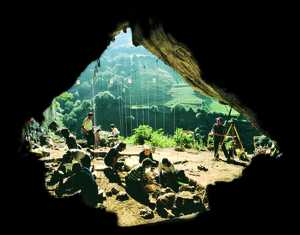gipuzkoakultura.net





We know very little about the first human beings to inhabit the territory that is now Gipuzkoa. On the basis of the information we possess to date, the first settlement was located in Irikaitz, (Zestoa), where a site has been unearthed dating from the lower Palaeolithic period. This find is currently being excavated and the dig will cast new light on those first settlers of Gipuzkoa, who lived here over 200,000 years ago. Like other sites from the lower Palaeolithic throughout the world, the Irikaitz dig will tell us when those first inhabitants came to the site, the climatic conditions in which they lived, the type of stone tools they owned, their means of subsistence and other matters related to their material culture. However, as I have said on other occasions, we shall still be left in the dark regarding other essential human issues: their image of the universe, their social and family structures, their misfortunes, joys and fears and their religious beliefs.
We have to wait until the mid Palaeolithic, dominated by Neanderthal man1, between 175,000 and 40,000 years ago, to get a closer view of the spiritual culture of our ancestors. It was during this era, examples of which may be found in Lezetxiki (Arrasate), Amalda (Zestoa) and other caves, that the first manifestations of this spiritual culture appear: burial sites, ochre, etc. These people probably used the ochre, which they brought into the caves from outside, to paint their bodies, either as a personal ornament or for some ritual purpose on specific occasions.
This is where our knowledge of the spiritual culture of that phase of mankind ends. It is not until the late Palaeolithic, an era which began some 40,000 years ago and lasted until about 10,000 years ago, that there is a major step forward in our understanding. It was during this period that the most striking manifestation of all prehistory occurred, admired by experts and laypersons alike: art. The first prehistorians were reluctant to believe that the magnificent paintings discovered in Altamira in 1878 were authentic. Some thought that the man who claimed to have discovered them was an impostor. Another twenty years were to go by before the great prehistorians of the time recognised that it really was Upper Palaeolithic man – Cro-Magnon man – who had produced these figures.
These examples give us a closer insight into the spirit of Stone Age man, although any research into prehistoric art is hindered by serious gaps in our knowledge, including one of the areas which interests us most: Why did those men paint and carve? What motives led them to create these figures? Why did they execute them in such deep areas of the caverns? We shall address this question in our examination of palaeolithic art in Gipuzkoa, which contains some very important examples.